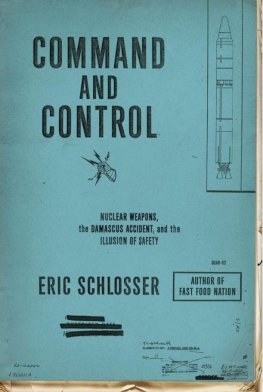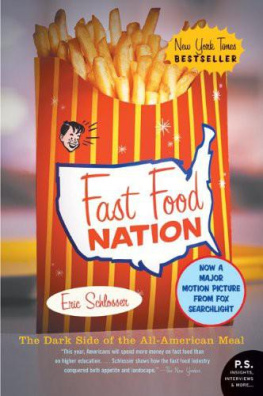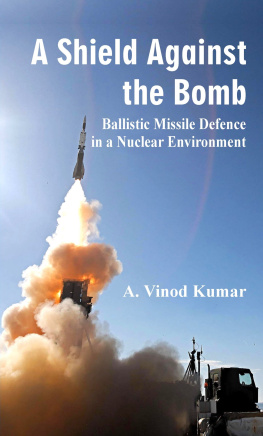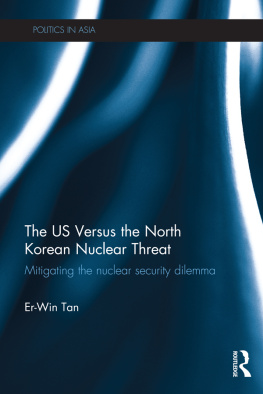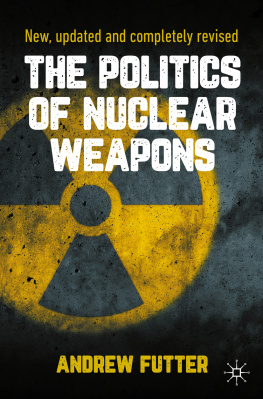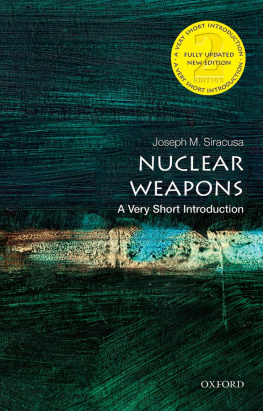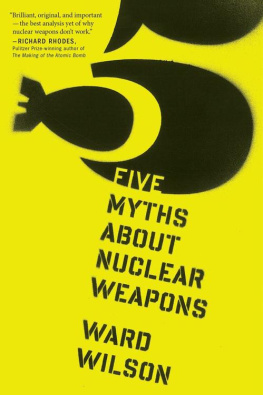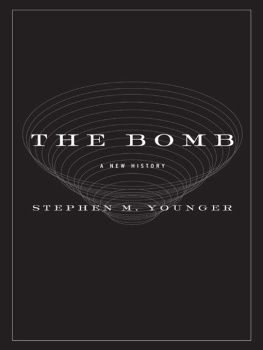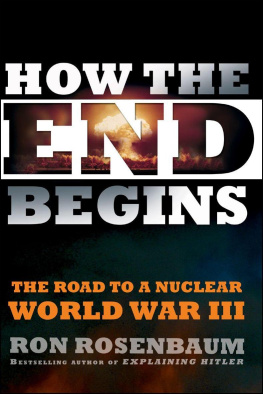Eric Schlosser
COMMAND AND CONTROL
Nuclear Weapons, the Damascus Accident, and the Illusion of Safety
Ring the bells that still can ring
Forget your perfect offering
There is a crack, a crack in everything
Thats how the light gets in.
Leonard Cohen
This is a book about the effort to control nuclear weapons to ensure that one doesnt go off by accident, by mistake, or by any other unauthorized means. The emphasis in these pages isnt on the high-level diplomacy behind arms control treaties. Its on the operating systems and the mind-set that have guided the management of Americas nuclear arsenal for almost seventy years. The history of similar efforts in the Soviet Union is largely absent here. Although no less important, such a history requires a knowledge of Russian archives and sources that I lack. Command and Control explores the precarious balance between the need for nuclear weapon safety and the need to defend the United States from attack. It looks at the attempts by American scientists, policy makers, and military officers to reconcile those two demands, from the dawn of the nuclear age until the end of the Cold War. And through the story of a long-forgotten accident, it aims to shed light on a larger theme: the mixture of human fallibility and technological complexity that can lead to disaster.
Although most of the events in this book occurred a long time ago, they remain unfortunately relevant. Thousands of nuclear warheads still sit atop missiles belonging to the United States and Russia, ready to be launched at a moments notice. Hundreds more are possessed by India, China, Pakistan, Israel, North Korea, Great Britain, and France. As of this writing, a nuclear weapon has not destroyed a city since August 1945. But there is no guarantee that such good luck will last.
The fall of the Berlin Wall now feels like ancient history. An entire generation has been raised without experiencing the dread and anxiety of the Cold War, a conflict that lasted almost half a century and threatened to annihilate mankind. This book assumes that most of its readers know little about nuclear weapons, their inner workings, or the strategic thinking that justifies their use. I hope readers who are familiar with these subjects will nevertheless learn a new thing or two here. My own ignorance, I now realize, was profound. No great monument has been built to honor those who served during the Cold War, who risked their lives and sometimes lost them in the name of freedom. It was ordinary men and women, not just diplomats and statesmen, who helped to avert a nuclear holocaust. Their courage and their sacrifices should be remembered.
SELECTED CAST OF CHARACTERS
THE TITAN II MISSILE COMBAT CREW
Captain Michael T. Mazzaro, the commander, a young officer from Massachusetts with a pregnant wife
Lieutenant Allan D. Childers, the deputy commander, raised in Okinawa, a former DJ in his late twenties
Staff Sergeant Rodney L. Holder, the ballistic missile systems analyst technician, son of a Navy officer, responsible for keeping the Titan II ready to launch
Staff Sergeant Ronald O. Fuller, the missile facilities technician, responsible for the equipment at the launch complex
Lieutenant Miguel Serrano, a trainee studying to become a deputy commander
PROPELLANT TRANSFER SYSTEM TEAM A
Senior Airman Charles T. Heineman, the team chief
Senior Airman David Powell, an experienced Titan II repairman, twenty-one and raised in Kentucky
Airman Jeffrey L. Plumb, nineteen and from Detroit, a novice receiving on-the-job training
PROPELLANT TRANSFER SYSTEM TEAM B
Sergeant Jeff Kennedy, a quality control evaluator for the 308th Strategic Missile Wing, perhaps the best missile mechanic at Little Rock Air Force Base, a former deckhand from Maine in his midtwenties
Colonel James L. Morris, the head of maintenance at the 308th Strategic Missile Wing
Senior Airman James R. Sandaker, a young missile technician from Evansville, Minnesota
Technical Sergeant Michael A. Hanson, the team chief
Senior Airman Greg Devlin, a junior middleweight Golden Gloves boxer
Senior Airman David L. Livingston, a twenty-two-year-old missile repairman from Ohio with a fondness for motorcycles
CIVILIANS IN AND AROUND DAMASCUS
Sid King, the twenty-seven-year-old manager of a local radio station
Gus Anglin, the sheriff of Van Buren County
Sam Hutto, a dairy farmer with land across the road from the missile site
THE DISASTER RESPONSE FORCE
Colonel William A. Jones, the head of the force as well as the base commander
Captain Donald P. Mueller, a flight surgeon manning the forces ambulance
Richard L. English, head of the Disaster Preparedness Unit, a civilian in his late fifties, still fit and athletic, nicknamed Colonel, whod served in the Air Force for many years
Technical Sergeant David G. Rossborough, an experienced first responder
SECURITY POLICE OFFICERS
Technical Sergeant Thomas A. Brocksmith, the on-scene police supervisor at the accident site
Technical Sergeant Donald V. Green, a noncommissioned officer in his early thirties who volunteered to escort a flatbed truck to Launch Complex 374-7
Technical Sergeant Jimmy E. Roberts, a friend of Greens who accompanied him on the drive to Damascus
AT THE LITTLE ROCK COMMAND POST
Colonel John T. Moser, commander of the 308th Strategic Missile Wing
AT THE SAC COMMAND POST IN OMAHA
General Lloyd R. Leavitt, Jr., the vice commander in chief of the Strategic Air Command
AT BARKSDALE AIR FORCE BASE IN LOUSIANA
Colonel Ben G. Scallorn, a Titan II expert at the Eighth Air Force whod worked with the missiles since the first silos were built
THE MANHATTAN PROJECT
General Leslie R. Groves, director of the project, who led the effort to build an atomic bomb
J. Robert Oppenheimer, a theoretical physicist, later known as the father of the atomic bomb, who served as the first director of the Los Alamos Laboratory
Edward Teller, a physicist later known as the father of the hydrogen bomb, often at odds with the other Los Alamos scientists
George B. Kistiakowsky, a chemist and perhaps the nations leading explosives expert, later the science adviser to President Dwight D. Eisenhower
SCIENTISTS AND ENGINEERS AT THE WEAPONS LABS
Bob Peurifoy, an engineer from Texas who joined Sandia in 1952 and subsequently became its leading advocate for nuclear weapon safety
Harold Agnew, a physicist from Colorado who helped create the first manmade nuclear chain reaction, filmed the destruction of Hiroshima from an observer plane, and played an important role in nuclear weapon safety efforts at the Los Alamos Laboratory
Carl Carlson, a young physicist at Sandia who in the late 1950s recognized the vulnerability of a nuclear weapons electrical system during an accident
Bill Stevens, an engineer who became the first head of Sandias nuclear safety department and worked closely with Bob Peurifoy
Stan Spray, a Sandia engineer who burned, crushed, and routinely tortured nuclear weapon components to discover their flaws
MILITARY LEADERS
General Curtis E. LeMay, an engineer who revolutionized American bombing techniques during the Second World War and turned the Strategic Air Command into the most powerful military organization in history
General Thomas S. Power, an Air Force officer who led the firebombing of Tokyo during the Second World War, followed LeMay to the Strategic Air Command, and gained the reputation of being a mean son of a bitch
General Maxwell D. Taylor, an Army officer who championed the nuclear strategy of limited war and served as influential adviser to President John F. Kennedy
OFFICIALS IN WASHINGTON, D.C.
David E. Lilienthal, the first chairman of the Atomic Energy Commission and a strong believer in civilian control of nuclear weapons

